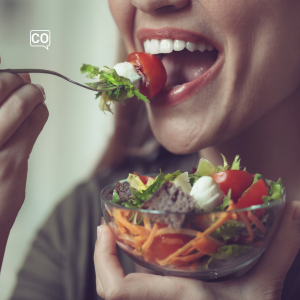Learn basic Dutch food vocabulary and simple conjunctions to talk about daily meals like breakfast, lunch, and dinner. Practice essential verbs and dialogue to communicate about eating habits, grocery shopping, and meal choices, suited for A1 beginners.
Listening & reading materials
Practice vocabulary in context with real materials.
Vocabulary (23) Share Copied!
Exercises Share Copied!
These exercises can be done together during conversation lessons or as homework.
Exercise 1: Reorder sentences
Instruction: Make correct sentences and translate.
Exercise 2: Match a word
Instruction: Match the translations
Exercise 3: Cluster the words
Instruction: Sort the words into two categories: vegetables and fruit.
Groenten
Fruit
Exercise 4: Translate and use in a sentence
Instruction: Pick a word, translated and use the word in a sentence or dialogue.
1
De koffie
The coffee
2
Het avondeten
The evening meal
3
De wortel
The carrot
4
De eieren
The eggs
5
De sla
The lettuce
Oefening 5: Conversation exercise
Instructie:
- Say what the people in the picture do. (Say what the people in the picture do.)
- Say the name of the dishes in the pictures. (Say the name of the dishes in the pictures.)
- What do you eat or drink? (What do you eat or drink? )
Teaching guidelines +/- 10 minutes
Example phrases:
|
Het meisje eet een boterham. The girl eats a sandwich. |
|
De man drinkt water. The man drinks water. |
|
De jongen eet eieren. The boy eats eggs. |
|
De vrouw drinkt een koffie. The woman drinks a coffee. |
|
Ik hou van thee bij het ontbijt. I like tea for breakfast. |
|
Ik drink water. I drink water. |
|
Ik eet brood met kaas. I eat bread with cheese. |
| ... |
Exercise 6: Dialogue Cards
Instruction: Select a situation and practice the conversation with your teacher or fellow students.
Exercise 7: Multiple Choice
Instruction: Choose the correct solution
1. Ik ___ elke dag om zeven uur.
(I ___ every day at seven o'clock.)2. Na het ontbijt ___ ik altijd koffie en melk.
(After breakfast I always ___ coffee and milk.)3. Mijn vriend ___ thee, maar ik drink liever water.
(My friend ___ tea, but I prefer to drink water.)4. In het weekend ___ ik meestal met brood en kaas.
(On the weekend I usually ___ with bread and cheese.)Exercise 8: Daily Eating
Instruction:
Verb Tables
Ontbijten - Having breakfast
Onvoltooid tegenwoordige tijd (OTT)
- ik ontbijt
- jij ontbijt
- hij/zij/het ontbijt
- wij ontbijten
- jullie ontbijten
- zij ontbijten
Drinken - Drinking
Onvoltooid tegenwoordige tijd (OTT)
- ik drink
- jij drinkt
- hij/zij/het drinkt
- wij drinken
- jullie drinken
- zij drinken
Eten - Eating
Onvoltooid tegenwoordige tijd (OTT)
- ik eet
- jij eet
- hij/zij/het eet
- wij eten
- jullie eten
- zij eten
Exercise 9: Nevenschikkende voegwoorden (en, maar, of, want)
Instruction: Fill in the correct word.
Grammar: Coordinating conjunctions (en, maar, of, want)
Show translation Show answersof, maar, en, want
Grammar Share Copied!
It's not the most exciting thing, we admit, but it’s absolutely essential (and we promise it'll pay off)!
A1.15.2 Grammatica
Nevenschikkende voegwoorden (en, maar, of, want)
Coordinating conjunctions (en, maar, of, want)
Verb conjugation tables for this lesson Share Copied!
Ontbijten to have breakfast Share Copied!
Onvoltooid tegenwoordige tijd (OTT)
| Dutch | English |
|---|---|
| (ik) ontbijt | I have breakfast |
| (jij) ontbijt / ontbijt | you have breakfast |
| (hij/zij/het) ontbijt | He/she/it has breakfast |
| (wij) ontbijten | we have breakfast |
| (jullie) ontbijten | you have breakfast |
| (zij) ontbijten | They have breakfast |
Drinken drink Share Copied!
Onvoltooid tegenwoordige tijd (OTT)
| Dutch | English |
|---|---|
| (ik) drink | I drink |
| (jij) dronk / drinkt | you drank / you drink |
| (hij/zij/het) dronk / drinkt | he/she/it drinks |
| (wij) drinken | we drink |
| (jullie) drinken | you drink |
| (zij) drinken | They drink |
Don't see progress when learning on your own? Study this material with a certified teacher!
Do you want to practice Dutch today? That is possible! Just contact one of our teachers today.
Daily Food in Dutch: Your Beginner's Guide (A1 Level)
This lesson focuses on everyday vocabulary and basic grammar around food and meals in Dutch. You will learn how to talk about what you eat and drink during the day, including breakfast, lunch, and dinner. The content is designed for A1 learners and introduces common conjunctions and useful phrases to help you describe daily eating habits clearly and naturally.
What You Will Learn
- Food Vocabulary: Learn essential words like de aardappel (potato), de appel (apple), de knoflook (garlic), and de banaan (banana), divided into categories such as vegetables (groenten) and fruits (fruit).
- Coordinating Conjunctions: Practice using simple Dutch conjunctions like en (and), maar (but), of (or), and want (because/for) to form more complex sentences, for example: "Ik drink koffie en eet brood bij het ontbijt." (I drink coffee and eat bread at breakfast.)
- Dialogues and Conversations: Engage in practical dialogues like discussing breakfast at home, lunch at work, and grocery shopping for dinner to help you communicate daily needs naturally.
- Verb Practice: Work on present tense conjugation of common verbs related to eating and drinking such as ontbijten (to have breakfast), drinken (to drink), and eten (to eat) with multiple-choice exercises and mini-stories.
Key Examples and Phrases
Examples like "Ik eet soep, maar ik voeg wel zout en knoflook toe." (I eat soup, but I do add salt and garlic.) show how to combine simple clauses using conjunctions. You will also encounter questions such as "Wil je thee of melk bij het brood?" (Do you want tea or milk with the bread?), promoting language useful in everyday conversations.
Instructional Differences
In Dutch, coordinating conjunctions often connect clauses without changing word order, unlike English which may use commas and conjunctions differently. For instance, "Ik drink koffie en eet brood" directly translates as "I drink coffee and eat bread," maintaining a straightforward structure. Phrases like "want" serve as causal connectors similar to "because," but usually appear in the middle of the sentence. Also, definite articles in Dutch (de and het) precede nouns, e.g., de appel (the apple), which is an important detail for proper sentence formation.
Useful phrases to remember: Wat eet jij meestal ’s ochtends? (What do you usually eat in the mornings?), Ik eet brood en drink altijd koffie. (I eat bread and always drink coffee.), and Wil je soep of salade eten? (Do you want to eat soup or salad?). These will help you in everyday discussions about food and meals.

































